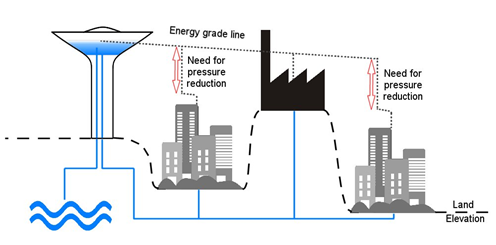
Water-Energy Nexus
Hydropower Energy Recovery in Water Pipe Networks
The water industry is the 4th most energy intensive sector in the UK responsible for considerable contributions to GHG emission. The largest share of this energy consumption is associated with the distribution of water in pipe networks and the subsequent collection in waste water networks.

Figure 1. Schematic illustration of the need for pressure reduction
Water utilities, service companies and researchers have been focused on improving the energy efficiency of water supply systems using numerous approaches in the recent past. This is principally driven by the need to reduce cost and environmental impacts, as well as to meet certain emissions or energy use targets.
One method to reduce the net energy consumption in water supply and distribution networks is through the incorporation of small- or micro-hydropower turbines at points of excess pressure within the pipe network.
Water networks are designed using a number of criteria, including minimum and maximum pressure. Too high pressure increases the risk of burst pipes and water leakage losses. A Pressure Reducing Valve (PRV) or Break Pressure Tank (BPT) is often installed in a water network where the pressure in pipelines becomes too high. This may arise where large drops in elevation occur producing an excessively large static pressure, which can then be reduced by a PRV or BPT to maintain pressure within the desired limits, as illustrated by Figure 1.
This reduction in pressure also results in a loss of energy from the system, which may be captured by using an appropriate hydropower technology.
In 2017/18 this committee aims to highlight the potential for energy efficiency improvements using this method in water networks. We also aim to highlight the barriers and bottlenecks which may hinder the exploitation of micro-hydropower in water networks in practice, including technical and non-technical considerations. Our key tasks shall include:
1. Collaboration & Communication in the water-energy sector
2. Webinar & Workshop
3. Papers and Journal Articles
Dr. McNabola is a Civil Engineering and Associate Professor in Energy and the Environment at Trinity College Dublin. Based in the Department of Civil, Structural & Environmental Engineering, Dr. McNabola has been involved in several EU-funded research projects examining various aspects of the use of micro-hydropower turbines in water pipe-networks since 2002. These include the current Dwr Uisce and REDAWN projects and the previous HydroBPT project. He has more than 15 years experience of working in academia and in practice focusing on the energy efficiency of environmental systems.
Steve Brown's career has focused on the water sector and helping to reduce water consumption in the built environment. He is currently in the final stages of completing a doctorate centred on water use during the design, construction and operation of non-domestic buildings. Additionally Steve works as a consultant on various projects related to the water sector.
Previous to this, he had a wider focus on sustainability, such as renewable energy, development of BREEAM criteria, and sustainability master planning. Steve has extensive experience in civil engineer design and construction project management. Many of these engineering projects required the design and supervision of the sustainable Urban Design (SUDS) systems. Over this career, his various roles have placed him as a project manager, researcher, author, designer, and facilitator. All of these roles related directly to sustainability and the built environment.
| Dr Kemi Adeyeye | WATEF network lead |
Terms of reference
Scope of activities
Meeting minutes/ Annual Reports/ Strategy documents
Events and activities



